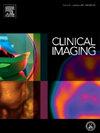The role of PSMA PET/CT in distinguishing malignant from benign solitary bone lesions in prostate cancer patients
IF 1.5
4区 医学
Q3 RADIOLOGY, NUCLEAR MEDICINE & MEDICAL IMAGING
引用次数: 0
Abstract
Purpose
This study evaluates the ability of prostate-specific membrane antigen (PSMA) positron emission tomography/computed tomography (PET/CT) to distinguish between benign and malignant solitary bone lesions (SBLs) in prostate cancer (PCa) patients in correlation with standard imaging and clinical features.
Methods
18F-piflufolastat and 68Ga-gozetotide PSMA PET/CT imaging reports of 1480 PCa patients from September 2021 to February 2023 were retrospectively reviewed. SBLs were classified as benign, malignant, or indeterminate based on imaging reports. Indeterminate SBLs were followed up over six months for reclassification. Comparative analyses, including Wilcoxon rank sum and chi-squared tests, assessed differences in standardized uptake values on PET, prostate-specific antigen (PSA) levels, and lesion locations.
Results
208 of 1480 (14 %) PSMA PET/CT scans reported an SBL. 106/208 (51 %) SBLs were malignant, 56/208 (27 %) benign, and 46/208 (22 %) indeterminate. Compared to benign lesions, malignant SBLs had a significantly higher SUVmax [5.20 (2.86–11.13) vs. 2.21 (1.6–2.84); p < 0.001] and SUVmax/liver SUVmean [0.9 (0.51–2.31) vs. 0.44 (0.32–0.58); p < 0.001], although serum PSA levels were not significantly different. Malignant SBLs were most reported in pelvis (37/106, 35 %), while most benign SBLs were in ribs (31/56, 55 %). Presence or absence of non-osseous metastasis, and radiopharmaceutical type were not associated with significant differences in PSA, SUVmax, or the common locations of malignant or benign SBLs. Indeterminate SBLs were reclassified as benign in 20/46 (48 %) patients, most commonly in the ribs (19/46, 41 %).
Conclusion
Location, SUVmax, and SUVmax/liver SUVmean of SBL on PSMA PET/CT may help differentiate benign from malignant etiologies while considering other imaging and clinical features.
PSMA PET/CT在鉴别前列腺癌患者孤立性骨病变良恶性中的作用
目的探讨前列腺特异性膜抗原(PSMA)正电子发射断层扫描/计算机断层扫描(PET/CT)对前列腺癌(PCa)患者良恶性孤立性骨病变(SBLs)的鉴别能力与标准影像学和临床特征的相关性。方法回顾性分析2021年9月至2023年2月1480例PCa患者的PSMA PET/CT影像学报告。根据影像学报告将SBLs分为良性、恶性或不确定。不确定的SBLs随访超过6个月进行重新分类。比较分析,包括Wilcoxon秩和和卡方检验,评估PET、前列腺特异性抗原(PSA)水平和病变部位的标准化摄取值差异。结果1480例PSMA PET/CT扫描中有208例(14%)报告SBL。106/208例(51%)为恶性,56/208例(27%)为良性,46/208例(22%)不确定。与良性病变相比,恶性SBLs的SUVmax显著高于良性病变[5.20 (2.86-11.13)vs. 2.21 (1.6-2.84);p & lt;SUVmax/肝脏SUVmean [0.9 (0.51-2.31) vs. 0.44 (0.32-0.58);p & lt;0.001],但血清PSA水平无显著差异。恶性SBLs多见于骨盆(37/ 106,35 %),而良性SBLs多见于肋骨(31/ 56,55 %)。有无非骨性转移和放射性药物类型与PSA、SUVmax或恶性或良性SBLs常见部位的显著差异无关。不确定的SBLs在20/46(48%)患者中被重新分类为良性,最常见于肋骨(19/46,41%)。结论SBL在PSMA PET/CT上的位置、SUVmax及SUVmax/肝脏SUVmean可在综合其他影像学及临床特征的基础上鉴别其良恶性病因。
本文章由计算机程序翻译,如有差异,请以英文原文为准。
求助全文
约1分钟内获得全文
求助全文
来源期刊

Clinical Imaging
医学-核医学
CiteScore
4.60
自引率
0.00%
发文量
265
审稿时长
35 days
期刊介绍:
The mission of Clinical Imaging is to publish, in a timely manner, the very best radiology research from the United States and around the world with special attention to the impact of medical imaging on patient care. The journal''s publications cover all imaging modalities, radiology issues related to patients, policy and practice improvements, and clinically-oriented imaging physics and informatics. The journal is a valuable resource for practicing radiologists, radiologists-in-training and other clinicians with an interest in imaging. Papers are carefully peer-reviewed and selected by our experienced subject editors who are leading experts spanning the range of imaging sub-specialties, which include:
-Body Imaging-
Breast Imaging-
Cardiothoracic Imaging-
Imaging Physics and Informatics-
Molecular Imaging and Nuclear Medicine-
Musculoskeletal and Emergency Imaging-
Neuroradiology-
Practice, Policy & Education-
Pediatric Imaging-
Vascular and Interventional Radiology
 求助内容:
求助内容: 应助结果提醒方式:
应助结果提醒方式:


